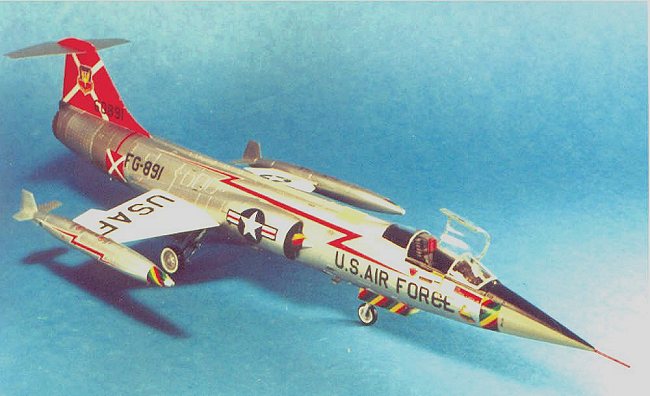
|
KIT # |
7219 |
|
PRICE: |
$28.95 |
|
DECALS: |
See Review |
|
REVIEW : |
|
|
NOTES: |
|

|
HISTORY |
Following 170 F-104A interceptors and 26 F-104B 2-seat trainers into production were 77 F-104C fighter-bombers for Tactical Air Command. They equipped the 479th TFW at George AFB from October 16, 1958. Powered by the J-79GE-7 with a 2 inch increase in turbine diameter providing 15,800 pounds of thrust with reduced specific fuel consumption, the F-104C introduced a probe for in-flight refueling that could be added or removed on the ground, and the option of carrying offensive stores on two underwing pylons and a centerline rack.
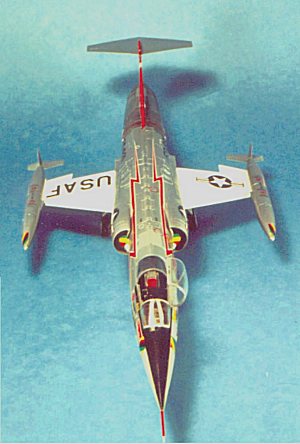 In the 1962 William Tell
competition, the 479th was represented by Captain Charles E. Tofferi. Ten other
competitors were mounted on the F-100, and three flew the F-105. Tofferi was
considered something of an interloper, since the primary mission of the 479th
was tactical nuclear delivery. Capt. Tofferi walked away from the Hun and Thud
drivers, scoring 19,018 points out of a possible 24,000 - 2,000 points ahead of
his nearest competitor. Three of his close-support missions were perfect 1,000s;
he scored the maximum 3,000 points possible for air-to-air gunnery by downing
the towed target in 63 seconds. This was the high point in the career of the
F-104C with the U.S. Air Force. That fall, the 479th transferred to Florida in
anticipation of flying strikes into Cuba had an invasion been the outcome of the
Cuban Missile Crisis; fortunately, they returned home to George AFB for
Thanksgiving.
In the 1962 William Tell
competition, the 479th was represented by Captain Charles E. Tofferi. Ten other
competitors were mounted on the F-100, and three flew the F-105. Tofferi was
considered something of an interloper, since the primary mission of the 479th
was tactical nuclear delivery. Capt. Tofferi walked away from the Hun and Thud
drivers, scoring 19,018 points out of a possible 24,000 - 2,000 points ahead of
his nearest competitor. Three of his close-support missions were perfect 1,000s;
he scored the maximum 3,000 points possible for air-to-air gunnery by downing
the towed target in 63 seconds. This was the high point in the career of the
F-104C with the U.S. Air Force. That fall, the 479th transferred to Florida in
anticipation of flying strikes into Cuba had an invasion been the outcome of the
Cuban Missile Crisis; fortunately, they returned home to George AFB for
Thanksgiving.
In 1965, with the war in Vietnam becoming thoroughly Americanized, the Starfighter was called to active duty. Your reviewer remembers looking up from the deck of the U.S.S. "Pine Island" in Da Nang harbor to see F-104Cs of the 435th TFS on the break for landing over Da Nang airfield in April, 1965; it's true that the Starfighter made a sound like no other jet. Their assignment was top cover for the F-100s and F-105s flying strikes into North Vietnam in Operation Rolling Thunder. The Starfighters had a secondary air intercept mission, on the off-chance the People's Army Air Force of Viet Nam sent their few Il-28 bombers to strike Da Nang. Unfortunately, the F-104 was too short-ranged to be a good escort fighter; all the North Vietnamese had to do was wait till the Starfighters turned back before launching their MiGs. One Starfighter was lost in air combat when it was shot down south of Hainan Island by Chinese MiG-19s and the pilot became the only F-104 POW. The 435th TFS returned to the United States with the bombing halt in December 1965. The 479th sent F-104s to Udorn Thailand in May 1966, again on the possibility of intercepting suicidal Il-28s; with the lack of any action by the North, the aircraft received a ground attack assignment, but could only carry two 1,000 lb. bombs and its range was even more limited than in the fighter configuration. The F-104s took part in Operation Bolo, a successful Air Force attempt to lure the MiGs into the air where the idiotic Rules of Engagement turned them into legitimate targets. While the F-104s were unsuccessful, Colonel Robin Olds led his F-4s from the 8th TFW into a heavy engagement where they scored well. In SEA, total losses included 1 F-104 shot down by MiGs, 2 F-104s shot down by SAMs, 6 by AAA, and 6 to non-combat causes. The Starfighters returned to ConUs in 1967, at which time the 479th converted to the F-4 and the F-104Cs were sent to the Puerto Rico Air National Guard, an organization that did not live up to its acronym when it came to F-104 operations that lasted until the summer of 1975.
|
THE KIT |
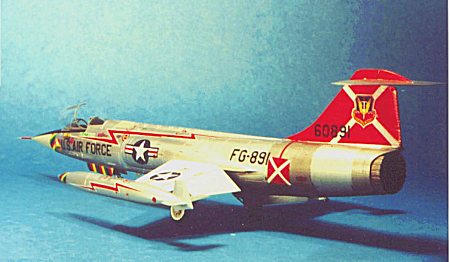 In the past decade,
Hasegawa has come to "own" the F-104 in 1/72 scale, producing the best
kits of this airplane done by any manufacturer. This release of the F-104C in
1/48 scale demonstrates their decision to do the same in the larger scale. As is
usual with Hasegawa kits, the molding is sharp and clean with a minimum of
flash, and a wealth of detail. The countersunk rivet detail on the wings and
tail section, while perhaps not "scale" in effect adds considerably to
the overall look of the completed model. The decal sheet provides two early NMF
F-104Cs of the 479th Tactical Fighter Wing, including the very brightly colored
FG-891, "Really George," the first F-104C delivered to the unit.
In the past decade,
Hasegawa has come to "own" the F-104 in 1/72 scale, producing the best
kits of this airplane done by any manufacturer. This release of the F-104C in
1/48 scale demonstrates their decision to do the same in the larger scale. As is
usual with Hasegawa kits, the molding is sharp and clean with a minimum of
flash, and a wealth of detail. The countersunk rivet detail on the wings and
tail section, while perhaps not "scale" in effect adds considerably to
the overall look of the completed model. The decal sheet provides two early NMF
F-104Cs of the 479th Tactical Fighter Wing, including the very brightly colored
FG-891, "Really George," the first F-104C delivered to the unit.
|
CONSTRUCTION |
There are no problems presented with this kit. Fit is excellent; I only had to apply a very little bit of Mr. Surfacer 500 to the center fuselage seam to get rid of it effortlessly. The only "fiddly" moment came with the assembly of the main gear, with the attachment linkage from the gear to the gear door, and this was easily accomplished. The kit instructions are clear and easy to follow. I did not assemble the wings and horizontal stabilizer to the fuselage until after I had painted the airplane, which considerably eased the masking job. Modelers should note that, regardless of the fact that the kit comes with open speed brakes, these snap shut on landing once power is reduced for taxying. A quick survey of Starfighter photographs will demonstrate this, so the brakes should be assembles closed.
|
PAINT & DECALS |
Painting:
The Starfighter presents a good opportunity to hone your skills in creating a multi-hue natural metal finish.
I painted the wings separately, with the upper surface a slightly toned-down white, and the under surfaces Aircraft Grey, which I also used for the nose. These were all Gunze-Sanyo paints. I then painted the anti-glare section of the nose flat black and masked all this off with drafting tape.
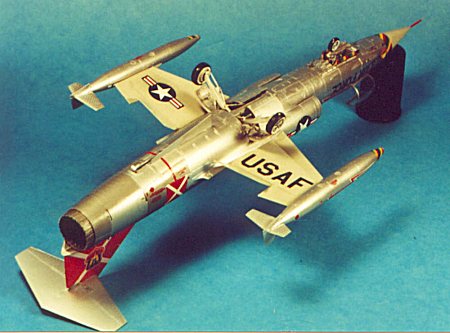 The fuselage, unassembled
landing gear, and horizontal stabilizer were all painted with SnJ Aluminum.
After it had about 20 minutes to dry, I applied SnJ polishing powder to the
fuselage forward of the speed brakes, and polished it. I had decided to do
"Really George," as it appeared upon delivery to the 479th TFW, with a
polished NMF forward fuselage. I then let everything dry overnight, and shot a
light coat of Future over the model the next day. When that was dry, I was ready
to mask off the various panels of the rear fuselage, which would be painted with
Testor's Model Master metalizer paints. SnJ advertises you can use a really
sticky masking tape on it successfully, but I chose to continue using drafting
tape. I also did the different panels of the vertical fin, since I was not sure
at the time that my plans for doing this red would work out; doing this left me
the alternative of doing the other airplane if necessary. As I did each color, I
Futured it, which allowed me to mask over it as needed. I think that using
Future instead of Sealer on metal finish airplanes that are going to have a
polished surface gives a better effect. I used Aluminum Plate, Magnesium,
Stainless Steel and Burned Metal from the Model Master colors.
The fuselage, unassembled
landing gear, and horizontal stabilizer were all painted with SnJ Aluminum.
After it had about 20 minutes to dry, I applied SnJ polishing powder to the
fuselage forward of the speed brakes, and polished it. I had decided to do
"Really George," as it appeared upon delivery to the 479th TFW, with a
polished NMF forward fuselage. I then let everything dry overnight, and shot a
light coat of Future over the model the next day. When that was dry, I was ready
to mask off the various panels of the rear fuselage, which would be painted with
Testor's Model Master metalizer paints. SnJ advertises you can use a really
sticky masking tape on it successfully, but I chose to continue using drafting
tape. I also did the different panels of the vertical fin, since I was not sure
at the time that my plans for doing this red would work out; doing this left me
the alternative of doing the other airplane if necessary. As I did each color, I
Futured it, which allowed me to mask over it as needed. I think that using
Future instead of Sealer on metal finish airplanes that are going to have a
polished surface gives a better effect. I used Aluminum Plate, Magnesium,
Stainless Steel and Burned Metal from the Model Master colors.
Decals:
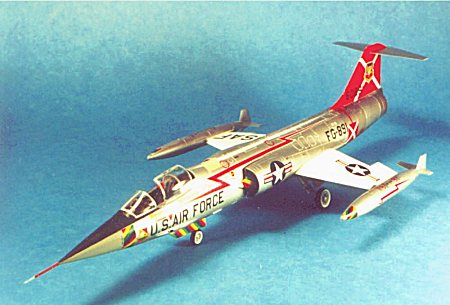 Once the model was dry,
I applied the red decal to the vertical fin as I had planned. This sheet was not
completely opaque, and did in fact provide the same shade of red that were on
the kit decals. Once that was resolved, I continued applying the markings for
"Really George." There is a photo of this airplane upon arrival at
George AFB in "Wings of Fame" Volume 2, which shows the "Really
George" name applied to the left side of the airplane in place of a marking
panel; Hasegawa's instructions say to apply this to the right side of the
airplane. I suspect the truth is that it was on both sides, but since I only had
the one decal and definite photographic proof it was on the left side, that's
where I put it.
Once the model was dry,
I applied the red decal to the vertical fin as I had planned. This sheet was not
completely opaque, and did in fact provide the same shade of red that were on
the kit decals. Once that was resolved, I continued applying the markings for
"Really George." There is a photo of this airplane upon arrival at
George AFB in "Wings of Fame" Volume 2, which shows the "Really
George" name applied to the left side of the airplane in place of a marking
panel; Hasegawa's instructions say to apply this to the right side of the
airplane. I suspect the truth is that it was on both sides, but since I only had
the one decal and definite photographic proof it was on the left side, that's
where I put it.
There are a lot of decals for this airplane, and I ended up putting them on in different sessions. Session One - after insuring the correct color for the vertical fin - involved the national markings. Session Two involved the group markings - all the red lightning bolts, the multi-color wraparound stripes, etc. Session Three was devoted to all the servicing markings. Once all this was completed, I washed the model thoroughly and then gave it a final thin coat of Future to seal everything.
Final Assembly:
I attached the wings and horizontal stabilizer, then the tip tanks. The landing gear went on with no problem, though I did have a bit of difficulty painting the tires with the white sidewalls this airplane appears in the WOF photo. I attached the canopy in the open position and did not attach the refueling probe as that detracted from the overall lines of the airplane.
|
CONCLUSIONS |
I don't think there is a "bad angle" from which to view an F-104. This is surely the most dramatic-looking airplane ever made. Hasegawa's model fully captures the lines of this airplane which - with the B-58 - epitomizes U.S. aeronautical philosophy of the 1950s: faster, higher and faster yet.
Copyright ModelingMadness.com. All rights reserved. No reproduction in part or in whole without express permission.
If you would like your product reviewed fairly and fairly quickly, please contact the editor or see other details in the Note to Contributors.